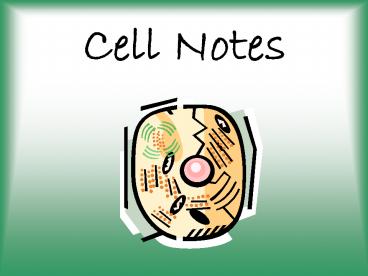Cell Notes - PowerPoint PPT Presentation
1 / 29
Title:
Cell Notes
Description:
Cell Notes Characteristics of Biotic Factors Made of cells. Respond and adapt to their environment Grow and develop Reproduce - Use energy. Maintain Homeostasis Cell ... – PowerPoint PPT presentation
Number of Views:211
Avg rating:3.0/5.0
Title: Cell Notes
1
Cell Notes
2
Characteristics of Biotic Factors
- Made of cells.
- Respond and adapt to their environment
- Grow and develop
- Reproduce -
- Use energy.
- Maintain Homeostasis
3
Cell Theory
- All living things are made up of cells.
- Cells are the basic unit of structure and
function in living things - All cells are produced from other cells
4
Living Needs
- Energy
- Water
- Living Space
- Homeostasis
- Stable Internal Conditions
cell
5
Examples of Cells
Amoeba Proteus
Plant Stem
Bacteria
Red Blood Cell
Nerve Cell
6
Over 200 different types of human cells
Erythrocytes
Fibroblasts
Epithelial cells
(a) Cells that connect body parts, form
linings, or transport gases
Nerve cell
Skeletal Muscle cell
(e) Cell that gathers information and
control body functions
Smooth muscle cells
(b) Cells that move organs and body parts
Sperm
Macrophage
(f) Cell of reproduction
Fat cell
(d) Cell that fights disease
(c) Cell that storesnutrients
7
Generalized Cell
- All cells have some common structures and
functions - Human cells have three basic parts
- Plasma membraneflexible outer boundary
- Cytoplasmintracellular fluid containing
organelles - Nucleuscontrol center
8
Prokaryotic
An organism whose cells lack a true nucleus and
Some other cell structures.
- Do not have structures surrounded by membranes
- Few internal structures
- Unicellular
- EX Bacteria
http//www.wiley.com/legacy/college/boyer/04700037
90/animations/cell_structure/cell_structure.htm
http//library.thinkquest.org/C004535/prokaryotic_
cells.html
9
Eukaryotic
An organism with cells that contain nuclei and
other cell structures.
Plant
Animal
http//www.wiley.com/legacy/college/boyer/04700037
90/animations/cell_structure/cell_structure.htm
http//library.thinkquest.org/C004535/eukaryotic_c
ells.html
10
Prokaryotic Cells Eukaryotic Cells
1/10 the size of eukaryotic cells Large compared to prokaryotic cells
Nucleus is not a membrane bound organelle Membrane bound nucleus w/ a nucleolus
Single circular DNA Many chromosomes w/ linear DNA
No membrane bound organelles MB Golgi, lysosomes, ER, mitochondria
11
Prokaryotic and Eukaryotic Cells Similarities
Both have ribosomes and cytoplasm Both require a supply of energy
Both have DNA as their genetic material
Both are covered by a plasma (cell) membrane Both are made from the same basic chemicals carbohydrates, proteins, nucleic acid, minerals, fats and vitamins. Both regulate the flow of the nutrients and wastes that enter and leave them
12
Nuclear envelope
Chromatin
Nucleolus
Nucleus
Smooth endoplasmic reticulum
Plasma membrane
Mitochondrion
Cytosol
Lysosome
Centrioles
Centrosome matrix
Rough endoplasmic reticulum
Ribosomes
Golgi apparatus
Secretion being released from cell by exocytosis
Cytoskeletal elements Microtubule
Intermediate filaments
Peroxisome
13
Cell Parts
- Organelles Small cell structures
14
Surrounding the Cell
15
Cell Membrane
- All cells contain a cell membrane
- Controls movement in and out of the cell
- Double layer
http//library.thinkquest.org/12413/structures.htm
l
16
Cell Walla rigid layer of nonliving material
that surrounds the cells of plants and some other
organisms.
- The outermost structure of the cell
- Most commonly found in plant cells bacteria
- Supports protects cells
http//library.thinkquest.org/12413/structures.htm
l
17
Inside the Cell
18
Nuclear Membrane
- Surrounds nucleus
- Made of two layers
- Openings allow material to enter and leave
nucleus
http//library.thinkquest.org/12413/structures.htm
l
19
Nucleus
- Directs cell activities
- Separated from cytoplasm by nuclear membrane
- Contains genetic material - DNA
20
Chromosomes
A rod-shaped cellular structure made of
condensed chromatin
- In nucleus
- Made of DNA
- Contain instructions for traits characteristics
http//library.thinkquest.org/12413/structures.htm
l
21
Nucleolus
- Inside nucleus
- Create ribosomes
- Contains RNA to build proteins
http//library.thinkquest.org/12413/structures.htm
l
22
Cytoplasm
- Gel-like mixture 80 water
- Located between the nucleus and cell membrane
- Many organelles found suspended within the
cytoplasm
Cyto cell
Plasm to form or mold
23
Endoplasmic Reticulum
- Transport system - Moves materials to Golgi
- Smooth type lacks ribosomes
- Rough type (pictured) ribosomes embedded in
surface
http//library.thinkquest.org/12413/structures.htm
l http//www.biology.arizona.edu/cell_bio/tutorial
s/pev/page3.html
24
Ribosomes
- Make proteins
- Each cell contains thousands - found on ER
floating throughout the cytoplasm
http//library.thinkquest.org/12413/structures.htm
l
25
Mitochondria
- Produces energy through chemical reactions THE
POWERHOUSE OF THE CELL - Controls level of water and other materials in
cell - Recycles and decomposes proteins, fats, and
carbohydrates
http//library.thinkquest.org/12413/structures.htm
l
26
Golgi Bodies
- Sorts, modifies, stores, packages distribute
materials - Move materials within out of the cell
http//library.thinkquest.org/12413/structures.htm
l
27
Lysosome
- Transports undigested material to cell membrane
for removal - Contain digestive enzymes break down old cell
parts, cells, bacteria, and viruses - Cell breaks down if lysosome explodes
http//library.thinkquest.org/12413/structures.htm
l
28
Vacuoles
- Membrane-bound sacs for storage, digestion, and
waste removal - Contains water solution
- Help plants maintain shape
http//library.thinkquest.org/12413/structures.htm
l
29
Chloroplast
- Usually found in plant cells
- Contains green chlorophyll
- Where photosynthesis takes place
http//library.thinkquest.org/12413/structures.htm
l
http//www.wiley.com/legacy/college/boyer/04700037
90/animations/cell_structure/cell_structure.htm































